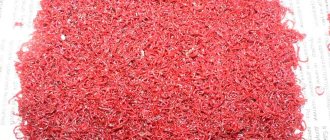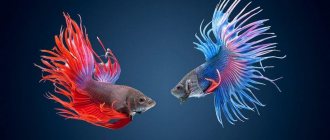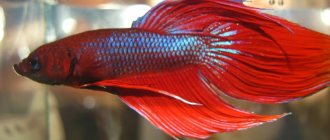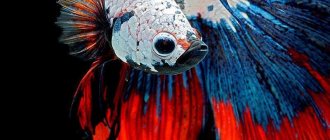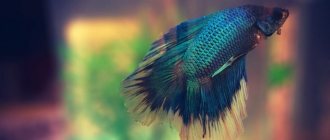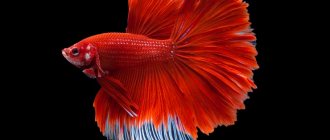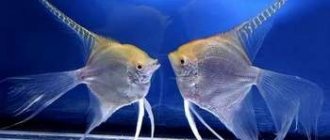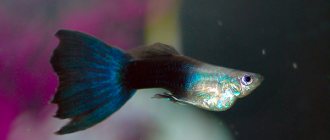Cockerel
The cockerel is an amazing fish in many ways. Its appearance, labyrinthine breathing and nest building undoubtedly captivate hobbyists. But how to create suitable conditions for the prosperous life of this extraordinary fish. The first thing you need to know about the betta fish is how to feed it.
In the wild, a betta is constantly in search of food, which means it spends a lot of energy. Therefore, wild bettas must consume more food than aquarium bettas, because... the latter move less and do not waste energy searching for food.
FEEDING A COCKER FISH: THE MAIN RULE
In a natural reservoir, the betta fish is in a constant active search for food in order to survive. Aquarium fish do not spend as much energy searching for food, so the amount of food consumed in an aquarium should be several times less.
A caring owner can be confused by the fish’s desire to consume food without stopping. The thought immediately arises that the pet is not eating enough. But the main rule in feeding applies here - it is better not to overfeed than to overfeed! A healthy fish will always eat the entire portion and “ask” for more.
Malnutrition is not as bad for a betta as overeating. In the wild, malnutrition is a common condition for fish. But overfeeding is unnatural and destructive: at best it will lead to obesity, lethargy and shortened life expectancy, and at worst – to death.
Advice!
It is important to choose the right not only food for the fish, but also its size. A betta has a small mouth, so pellets or flakes should be small in size, and large live food should be crushed.
Conditions of detention
It is very important to create favorable environmental conditions in the aquarium so that the fish not only feel comfortable and do not get sick, but also actively reproduce.
Required environment settings:
- aquarium volume – 40-50 liters for a couple (male and female);
- water temperature – 25-28 °C;
- acidity – 6.0-8.0 pH;
- alkalinity – 5-15 dH;
- be sure to leave a layer of air of 10-12 centimeters and provide the aquarium with a lid;
- You can install a one- or two-stage filter as desired;
- You can take any soil, but individuals with dark colors will look more advantageous on a light background, and bright and colorful fish on black and dark gray soil;
- Among the plants, the best options would be hornwort, cryptocoryne and vallisneria.
The betta is considered an easy species to keep, so even a novice aquarist can cope with its cultivation and breeding.
WHAT TO FEED A COCKER FISH
Betta fish are omnivores in the wild.
They consume plant and animal food: they pluck aquatic plants (algae or Java moss), catch insects from the surface of the water or grab them in a jump, eat insect larvae, small crustaceans, worms, look for ground organisms (benthos) at the bottom, etc. When developing a diet for bettas, keep in mind that they need not only plant foods, but also protein.
The standard food for aquarium bettas is artificial dry food (small granules and flakes), which can be purchased at any pet store. Bettas also love live food (fresh, frozen or dried) and plant foods.
This does not mean that there should be a lot of food. For a cockerel, it is better to choose several types of food and feed them alternately.
Advice!
For one feeding - one type of food. There is no need to combine different types of feed. For example, frozen foods should not be given at the same time as dry foods.
Ready-made dry food
Ready-made dry mixes ( pellets, flakes
) are fish feeds that are balanced in their composition. They can be bought at a pet store, they are inexpensive and easy to use and store.
Is it possible to constantly feed a betta fish with dry mixtures? Experts have different opinions.
Most argue that for the normal functioning of an aquarium fish, in addition to dry food, it is necessary to provide live food, since bettas in the wild consume a lot of proteins.
Some experts say that ready-made mixtures are sufficient in the diet of bettas, since manufacturers develop feed compositions that are as close as possible to the biological needs of these fighting fish. The choice is up to the aquarist. We adhere to the first opinion.
1.1
.
Special pellets for bettas
What are granules?
Granules are a type of ready-made food in which all useful substances are balanced, nutritional value is preserved as much as possible with minimal addition of preservatives and stabilizers. They are nutritious, safe, inexpensive and easy to store.
There are different types of pellets, but it is worth choosing those that are designed specifically for bettas ( Betta splendens
).
Betta pellets can be fed daily and are suitable as a main food.
Advice!
The protein content of granulated food for cockerels should be at least 40%.
1.2.Fish flakes
Fish flakes are another type of prepared fish food that comes in the form of thin, lightweight plates. They are suitable for fish living in the upper and middle layers of water, as due to their light weight they float on the surface of the water. The flakes get soggy quickly, making them great for small-mouthed fish like bettas.
The flakes are sold in pet stores and are inexpensive.
On sale you can find flakes of different compositions, colors and sizes. If you feed your betta mainly only flakes, then you need flakes recommended for daily feeding of bettas. If you feed your fish with flakes in addition to the main menu, you can take a fortified composition.
However, many experienced aquarists do not recommend giving flakes to your betta every day, but only as an addition to the main food.
Advice!
Tropical and goldfish flakes are not suitable for betta fish.
Live food
Cockerels are small predators that consume a lot of protein food in natural bodies of water. Live fish food is needed for energy, and it is also a favorite treat for bettas.
Live food can be fresh, frozen or dried. It can be found year-round in pet stores or in a regular fishing store.
2.1.Fresh live food
Most often, common bloodworms, brine shrimp, daphnia, raspberries, earthworms or flatworms are chosen to feed betta fish. Siamese cockerels will not refuse live insects and their larvae, snails, zooplankton or ground seafood.
The most common live food is bloodworms. It can be bought in different sizes. In order for the cockerel to cope with its food, you need to choose the smallest bloodworm.
In the summer, some aquarists, wanting to pamper their pets, catch various aquatic inhabitants in reservoirs. We do not recommend doing this, because there are many cases where, along with such delicacies, parasites were introduced directly from the reservoir into the aquarium and the fish died.
But not only self-caught live food is fraught with danger. Worms, bloodworms and other purchased live food may be contaminated. As a result, an infection is introduced into the aquarium. In our opinion, it is better not to risk it, but to freeze it.
Advice!
Live tubifex often carries parasites or bacteria and is best avoided when alive.
2.2.Frozen live food
As already noted, the protein component in the diet for energy is important for cockerels, and they also love live food. And frozen food is the same as live food, with the same properties, only much safer.
When frozen, bettas eat the following: bloodworms, brine shrimp, daphnia, tubifex worms, glass worms, earthworms, shrimp and beef heart.
You can catch a lot of it yourself or buy a small batch from a supplier and put it in the freezer to freeze. Products must be fresh and clean.
When feeding, you just need to chop off the required amount of food, and return the rest back to the freezer. The cockerel will definitely appreciate this food.
Advice!
Do not defrost or re-freeze live food, as such food loses its beneficial properties and becomes unsuitable for consumption.
2.3.Dried live food
Dried and processed bloodworms, tubifex, brine shrimp and others are available in most pet stores.
You can feed your betta with this dry food often; it is suitable as a daily food.
Plant food
Plant food is given in the form of scalded lettuce leaves.
COCKER FISH: MAINTENANCE AND CARE
Description of the fish
Otherwise, this species is called betta fish, Siamese cockerel, chicken or betta splendens. Belongs to the Order Perciformes of the Genus Betta. Animals live in Southeast Asia in stagnant fresh water bodies. Thanks to the presence of probes (since they belong to the Labyrinthine Class), fish can navigate in muddy and colored water, and for this reason they often swim in sewers.
They have a very memorable appearance. The body of the animal is elongated and slightly flattened on the sides, decorated with short thin fins and luxurious veil tails in males. The scales are shiny, their color can be anything: from variegated red-blue with purple splashes to plain black or white. Females reach four centimeters in length, males – 4.4.5. Such beauties live quite short lives - they rarely exceed the five-year threshold. The average life expectancy is three years.
The fish are relatively peaceful in relation to other species of similar size. They get along best with small catfish, tetras, swordtails and zebrafish. But among their relatives they are distinguished by aggression, hierarchy and pronounced territorial behavior. Males can fight and even inflict fatal injuries on each other. It’s not for nothing that in the countries of Southeast Asia they even used to hold fights with the participation of these fish. Sometimes the winning males do not allow the losers to approach the water's edge. And since the cockerels can additionally breathe atmospheric air, in muddy water at the bottom they die from suffocation.
The main feature of rearing lies in the character: it is better to keep fish in small groups: one male and two to four females. Otherwise, the fish are unpretentious and are not selective in food. Food for cockerels and fish of the closest genera differs little from each other.
HOW MUCH FOOD SHOULD I GIVE A COCKER FISH?
All fish are individual and no one can definitely tell you the exact dosage.
You can usually find the following recommendations :
- if we are talking about granules, then give 1-2 pieces per feeding,
- if it’s flakes, then 2-3 medium-sized pieces per meal are enough,
- if you feed bloodworms (live or frozen), then 3 worms per day are enough for one fish.
Diseases
With good care at home, a cockerel can live for about 3 years. But if the aquarium is poorly maintained, overfed or fed with live food, there is a risk that the betta will get sick.
Diseases can lead to the death of a pet, so you should pay attention to the appetite and behavior of the fish, because these are the first signs of any ailment.
Fin rot:
- Symptoms. The edges of the fins first become dull, then erosion appears, which grows intensively over the entire surface of the fin. Then the process of rotting occurs, and the fin disintegrates.
- Causes. The causative agent of the disease is the bacterium Pseudomonas. It occurs due to poor quality or untimely cleaning of the aquarium, when feeding contaminated food or introducing infected fish and plants.
- Treatment is carried out with salt baths and streptocide. It is also important to disinfect the aquarium, change some of the water, and rinse the plants and soil.
Costiosis:
- Symptoms. A gray spot with copious mucus secretion and clouding of the skin are formed.
- Causes. The parasite is caused by a flagellate, which can be introduced into an aquarium with live food or infected fish.
- Treatment is carried out with furazalidone and malachite green. In this case, it is necessary to change the water by 20-30% every day. As a rule, fish recover within a week.
Dropsy:
- Symptoms are a swollen belly, raised scales, redness of the fins and abdomen, loss of appetite, apathy.
- Causes. Incorrect feeding of fish, supplementary feeding, infections.
- For treatment, use Bicillin 5, white streptocide, and a weak solution of potassium permanganate.
Ichthyophthiriasis:
- Symptoms. Small white dots (similar to semolina grains) appear on the fish's head, which spread throughout the body. Lethargy, loss of appetite, swims in jerks.
- Causes. Introduced into the aquarium with new fish or plants. The culprit may also be live food contaminated with ichthyophthyriasis.
- Treatment is carried out with salt baths, malachite green, bicillin 5, antipar preparations.
By following all the recommendations for caring for a cockerel, the fish will delight you with its beauty, absence of diseases and large offspring.
HOW OFTEN TO FEED A COCKER FISH
Diet is also important
.
In an aquarium environment, bettas do not require much energy. Therefore, it is enough to feed the betta fish 1-2 times a day in small portions. During the spawning period they need a little more energy and the fish are fed 2 times a day. As your cockerel ages, you can feed him less often, once a day.
As already noted, leftover food should be removed immediately after feeding, since it not only pollutes the aquarium, but also harms the health and coloration of the betta.
Many aquarists advise giving bettas “ unloading”
» days 1 time per week by selecting a specific day. This way, the digestive system will be able to recover, and the fish’s body will have time to get rid of accumulated toxins. Overeating is much worse for these fish than undereating. After the fasting day, the cockerel begins to be fed in very small quantities, gradually increasing the dose of food.
Interesting Facts
This popular aquarium fish is so entrenched in the history of aquarium farming that we do not even suspect that somewhere it was considered an ordinary and unremarkable animal.
Here are some amazing facts about this colorful fish:
- Now fights involving cockerels are prohibited. Although the fish did not die, they just ruffled each other's tails a little, such activity was officially prohibited as intentional cruelty to animals.
- Males are so aggressive and stupid that they can fight with their reflection to the point of complete exhaustion. This must be taken into account and not purchase tanks with mirror surfaces.
- These animals have two parallel respiratory systems: gills and a respiratory tube - a labyrinthine organ.
- Fighting pets very amusingly show sympathy for a possible partner: the female swims “back and forth”, flirting, and the male straightens his fluffy fins and tail, protrudes his gill covers and wriggles his whole body.
- During battle, bettas inflict deep wounds on each other and even tear off gill covers. Animals cannot bite, so they open their mouths with all their might and at speed plunge their teeth pointing forward into the enemy’s body.
Many experienced aquarists advise thoroughly studying the behavior of representatives of this species. If you are not confident in your abilities, it is better to buy one fish, because males can gnaw not only rivals, but also females that they do not like and are not suitable as partners. In such cases, the death of weak and smaller females is not uncommon.
DOES A COCKER NEED VITAMINS?
Constantly giving vitamins to aquarium fish does not make sense. Vitamins are given to fish only in some cases. For example, if the fish is stressed due to a move, the addition of a new resident to the aquarium, or the death of an old resident.
In these cases, to support the betta, you can purchase special vitamins for fish at a pet store and give them according to the instructions. There are additives that are simply added to the aquarium water or those that are included directly in the fish’s menu.
Errors
Common mistakes made by aquarists:
- Beginners often feed a cockerel, which does not refuse food, even if it has eaten too much. In addition, due to large portions, the water quickly becomes cloudy.
- Monotonous diet.
- Neglecting herbal supplements.
- Lack of cleaning after feeding. Uneaten food falls to the bottom, where it rots over time, reducing water quality.
It happens that the cockerel does not react to the food or spits it out. Reasons for refusing food:
- the fish is sick;
- food particles are not the right size;
- the cockerel is not accustomed to a particular dish;
- The product offered is of poor quality.
FEEDING COCKER FRY
The diet of betta fry differs from that of adult fish. In nature, babies eat plankton.
What to feed betta fry in an aquarium. Fry that have just emerged from larval age are fed live dust, which consists of tiny microorganisms. You can buy it at a pet store.
After about 2 weeks of life, plankton and fresh brine shrimp larvae can be given. When the size of the betta fry increases, they are given bloodworms and brine shrimp. As your fish grows, you can try feeding dry food. Pet stores sell special food for fry.
Due to their accelerated metabolism and rapid growth, the feeding frequency of young individuals should be every few hours.
Specialized feed mixtures
It's easy to get lost in the plethora of dry foods. Almost every manufacturer has offers for cockerels; in addition, food for guppies, labyrinth fish, and others is also suitable for them.
From the offered feeds, use the trial method to choose the one that suits your cockerel’s taste.
However, I urge you to pay attention to the most popular foods created specifically for bettas. They provide adequate nutrition for males and females at any time in their lives.
| Tetra | Tetra | Tetra | Tetra | Sera | Dajana |
| Betta | Betta Larva sticks | Betta Granules | Betta menu | Bettagran | Betta |
| Flakes. Excellent for juveniles. | Food in the form of sticks. They resemble worms and awaken the instincts of hunters. | The small granules of this food are excellent for bettas. | Positioned as a varied diet. It includes 4 types of feed - granules, 2 types of flakes and powder. | Red powdered food. Maintains color brightness. | These granules have a natural composition and are small in size. |
What should be in the diet?
A caring and conscientious owner always thinks about what to feed his betta fish. When choosing a menu, you should consider the presence of:
- protein component;
- minerals;
- vitamins;
- carbohydrates;
- biologically active substances.
This does not mean that there should be food . It is necessary to organize the diet in such a way that it intelligently combines all the essential components.
Ciliates
Ciliates are a type of food that is often recommended for betta fish fry. This type of feeding is ideal for newly hatched fry because the ciliates are small enough for the fry to handle with ease. Plus, the ciliates move, and this is also very attractive to the fry. Ciliates can be purchased online, and at pet markets and some pet stores you can buy a culture of ciliates and breed it yourself. To feed ciliates to your betta fry, simply use a pipette or small hose to collect some of the ciliates from the container where they are growing.
Spawning
The male is first introduced into the breeding aquarium. He begins to build a nest from air bubbles, holding them together with saliva and parts of floating plants. The result is a cap of foam that rises above the water. The bright coloring of the partner and the completion of construction are signals that the time has come for the placement of a pregnant female.
14:52
This is necessary! As ordered! Epic spawning of bettas
The cockerel chases the female, delivering sensitive blows. At some point, the cockerel wraps itself around its partner, squeezes the eggs out of its abdomen and pours milk on it. The male picks up the fertilized eggs and carries them to the nest. The mating process is repeated 1-4 times. A sign of the end of reproduction: the male is busy with the nest, the female is hiding in a shelter. The female fish needs to be removed at this time.
If the males do not start breeding, they take measures: raise the temperature to +30˚C, soften the water using peat additives from the pet store, change some of the water. During one spawning, the female lays more than 600 whitish eggs of irregular shape.
The male wraps himself around the female and helps her push out the eggs.
Cockerels are not fed during breeding so as not to spoil the quality of water in the spawning area. This does not have any negative consequences for adult fish.
